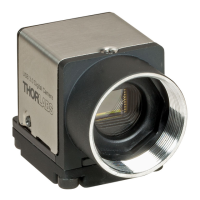© 2016 Thorlabs Scientific Imaging50
DCx Camera Functional Description and SDK Manual
2.6 Camera Parameters
Pixel clock, frame rate, exposure time
Gain and offset
Automatic image control
Applying new parameters
2.6.1 Pixel Clock, Frame Rate, Exposure Time
Pixel clock
The basic parameter for camera timing is the pixel clock. It determines the speed at which the
sensor cells can be read out.
Attention
We recommend not setting the pixel clock any higher than necessary to achieve the desired frame
rate.
An excessive pixel clock can cause delays or transmission errors. If the data is read from the
sensor at a higher speed (high pixel clock), you will also need a faster transmission over the data
connection. Thus, by controlling the pixel clock, you can also influence the bandwidth required for a
camera.
The pixel clock influences the connected load and consequently the temperature inside the camera.
Frame rate
The possible range of settings for the frame rate depends on the currently selected pixel clock. You
can select a lower frame rate without changing the pixel clock. To set a higher frame rate, however,
you need to increase the pixel clock.
Exposure time
The exposure time depends on the currently selected frame rate and is preset to its reciprocal
value. You can select a shorter exposure time without changing the frame rate. To set a longer
exposure time, however, you need to reduce the frame rate.
Note
The increments for setting the exposure time depend on the sensor's current timing settings (pixel
clock, frame rate). The exposure time values are rounded down to the nearest valid value, if
required. For this reason, the actual exposure time can deviate slightly from the exposure time you
have selected.
See also:
ThorCam: Settings > Camera
is_PixelClock()
is_SetFrameRate()
is_Exposure()

